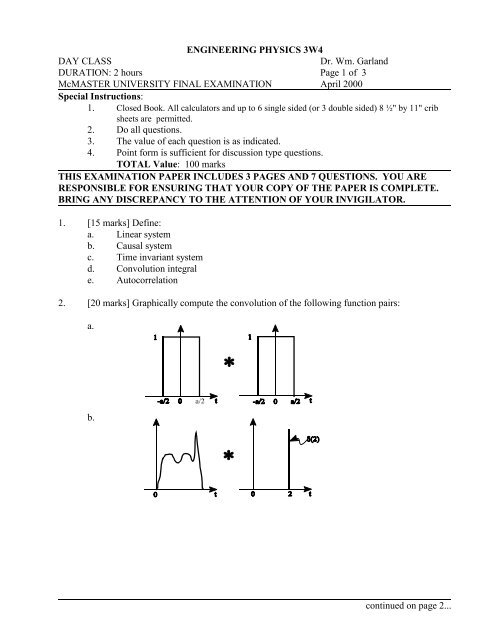Final - Bill Garland's Nuclear Engineering Page
Final - Bill Garland's Nuclear Engineering Page
Final - Bill Garland's Nuclear Engineering Page
You also want an ePaper? Increase the reach of your titles
YUMPU automatically turns print PDFs into web optimized ePapers that Google loves.
ENGINEERING PHYSICS 3W4<br />
DAY CLASS<br />
Dr. Wm. Garland<br />
DURATION: 2 hours <strong>Page</strong> 1 of 3<br />
McMASTER UNIVERSITY FINAL EXAMINATION April 2000<br />
Special Instructions:<br />
1. Closed Book. All calculators and up to 6 single sided (or 3 double sided) 8 ½" by 11" crib<br />
sheets are permitted.<br />
2. Do all questions.<br />
3. The value of each question is as indicated.<br />
4. Point form is sufficient for discussion type questions.<br />
TOTAL Value: 100 marks<br />
THIS EXAMINATION PAPER INCLUDES 3 PAGES AND 7 QUESTIONS. YOU ARE<br />
RESPONSIBLE FOR ENSURING THAT YOUR COPY OF THE PAPER IS COMPLETE.<br />
BRING ANY DISCREPANCY TO THE ATTENTION OF YOUR INVIGILATOR.<br />
1. [15 marks] Define:<br />
a. Linear system<br />
b. Causal system<br />
c. Time invariant system<br />
d. Convolution integral<br />
e. Autocorrelation<br />
2. [20 marks] Graphically compute the convolution of the following function pairs:<br />
a.<br />
b.<br />
continued on page 2...
<strong>Engineering</strong> Physics 3W4 <strong>Page</strong> 2 of 3<br />
c.<br />
d.<br />
3. [15 marks] Evaluate the following expressions:<br />
%4<br />
a. Evaluate δ(&2t&1) sinc(πνt) dt<br />
m<br />
&4<br />
b. Evaluate d dt ( a (t)<br />
c. Show that t f(t) W ( i . [Don’t panic; it’s easy!]<br />
2π ) dF(ν)<br />
dν<br />
4. [10 marks] Give brief answers to the following:<br />
a. In signal analysis, what is the advantage of reflecting a time signal about the origin<br />
b. Show how the convolution integral results from making a measurement. Assume a<br />
linear, time invariant, causal system.<br />
c. Why are Fourier Transforms so useful when dealing with convolutions<br />
d. Laplace and Fourier Transforms are similar. Why are Laplace transforms used more<br />
for solving differential equations and Fourier Transforms used more for signal<br />
analysis<br />
5. [10 marks] In the following, a proof is not required.<br />
a. What is the FT of [a(t)*b(t) + c(t).d(t)] 2<br />
b. What is the FT of Π 2 (t). Graph the result.<br />
c. What is the FT of exp(-πt 2 )<br />
continued on page 3...
<strong>Engineering</strong> Physics 3W4 <strong>Page</strong> 3 of 3<br />
6. [20 marks] An input step voltage, V 0 u(t), is passed through an ideal low pass filter. V 0 is the<br />
magnitude of the voltage and u(t) denotes the unit step.<br />
a. Sketch the input signal in time space.<br />
b. What does the ideal low-pass filter look like in frequency space<br />
c. What does the ideal low-pass filter look like in time space<br />
d. By working only in time space, determine the output voltage.<br />
e. What is the Fourier Transform of the input V 0 u(t) We denote this as V 0 φ(ν)<br />
f. What is the output voltage in frequency space, Y(ν)<br />
g. By performing the Inverse Fourier Transform of Y(ν), determine the output voltage in<br />
time space, y(t).<br />
h. Referring to both the time space and the frequency space, describe briefly what<br />
happens to the signal as it passes through the filter.<br />
7. [10 marks] We have shown that a sampled signal in frequency space is<br />
Ö(ν) ' j<br />
%4<br />
s(nT)e &2πiνnT<br />
n'&4<br />
.<br />
a. Show that is a periodic function.<br />
b. Discuss the ramifications for setting the sampling rate.<br />
c. Find the critical sampling rate.<br />
— END —
















